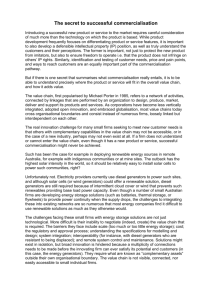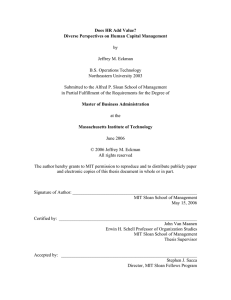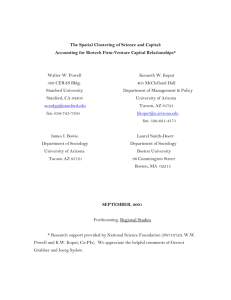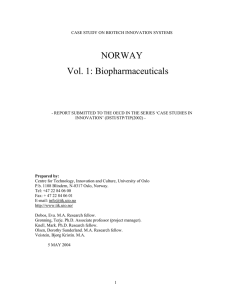clicking here
advertisement
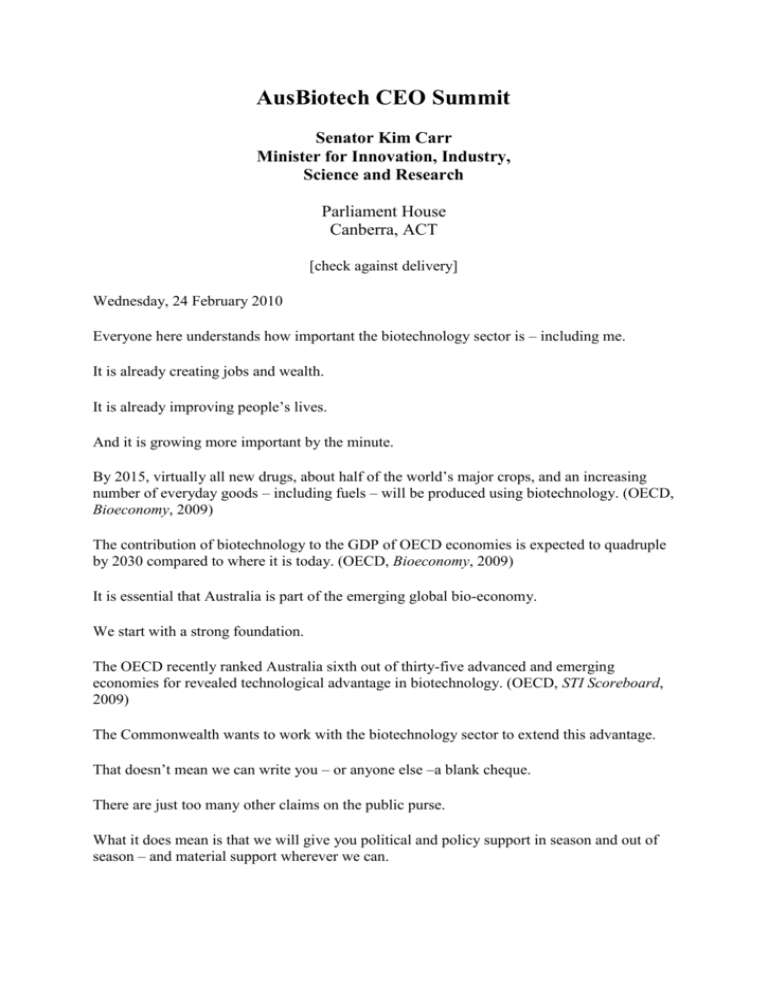
AusBiotech CEO Summit Senator Kim Carr Minister for Innovation, Industry, Science and Research Parliament House Canberra, ACT [check against delivery] Wednesday, 24 February 2010 Everyone here understands how important the biotechnology sector is – including me. It is already creating jobs and wealth. It is already improving people’s lives. And it is growing more important by the minute. By 2015, virtually all new drugs, about half of the world’s major crops, and an increasing number of everyday goods – including fuels – will be produced using biotechnology. (OECD, Bioeconomy, 2009) The contribution of biotechnology to the GDP of OECD economies is expected to quadruple by 2030 compared to where it is today. (OECD, Bioeconomy, 2009) It is essential that Australia is part of the emerging global bio-economy. We start with a strong foundation. The OECD recently ranked Australia sixth out of thirty-five advanced and emerging economies for revealed technological advantage in biotechnology. (OECD, STI Scoreboard, 2009) The Commonwealth wants to work with the biotechnology sector to extend this advantage. That doesn’t mean we can write you – or anyone else –a blank cheque. There are just too many other claims on the public purse. What it does mean is that we will give you political and policy support in season and out of season – and material support wherever we can. National Enabling Technologies Strategy The National Enabling Technologies Strategy released on Monday is the latest example. It succeeds the National Biotechnology Strategy, which lapsed in 2008, and the National Nanotechnology Strategy, which ended in 2009 – but it goes much further than this. Worth $38.2 million over four years, the new strategy provides a framework for the responsible development and use of emerging platform technologies. It includes: $18.2 million for nano-metrology and bio-metrology infrastructure at the National Measurement Institute $10.6 million to support policy and regulatory development, industry uptake, international collaboration, and strategic research and $9.4 million for public awareness and community engagement. The strategy recognises that we cannot take industries like this one forward and leave the community behind. It will build public confidence in new technologies: by explaining them by ensuring they yield maximum benefits and by addressing legitimate concerns about health, safety and the environment. There will be a Stakeholder Advisory Council to advise the Government on delivering the strategy and an Expert Forum for Enabling Technologies to identify and anticipate trends. We will be looking for opportunities to work with industry, researchers and other groups to get things done as effectively as possible. Super Science The National Enabling Technologies Strategy is part of the Future Industries component of the Super Science Initiative, funded in the 2009 Budget to support the Government’s Powering Ideas innovation agenda. The Super Science Initiative is worth $1.1 billion and it is building strategic infrastructure that will increase the effectiveness of the national innovation system as a whole. The biotechnology sector will benefit from investments in: DNA sequencing and bio-informatics infrastructure a new Australian lab to partner with the European Molecular Biology Laboratory pre-clinical testing facilities and other infrastructure to support drug discovery and the development of novel therapies an integrated online biodiversity database better plant and animal phenomics research facilities and improved infrastructure for linking population health data. The Super Science Initiative will involve and encourage collaboration between universities, government research agencies, independent research institutes and business to ensure that research outcomes are translated into new and improved products. R&D Tax Credit Another headline item in the Powering Ideas package is the new R&D Tax Credit. It will be worth about $1.4 billion a year to business. There will be: a 45 per cent refundable tax credit for firms with a turnover up to $20 million and a 40 per cent non-refundable tax credit for all other firms. Firms in tax loss can take the refundable credit as cash. This is a very significant benefit, and it will make a huge difference to start-up and earlystage firms in this industry. The new scheme is simpler and more generous than the existing R&D Tax Concession. Because the tax credit is decoupled from the corporate tax rate, it is also more predictable. International firms will be able to claim the R&D Tax Credit, regardless of where the intellectual property is owned, as long as R&D is performed at a permanent establishment in Australia. This is a great reform in an area where reform is desperately needed. Last year, 80 per cent of the R&D Tax Concession went to just 100 companies. The remaining 7,900 firms registered for the scheme divided the balance between them. The other two million Australian businesses stayed home. Not everyone sees this as a problem, but I do. We need a lot more companies doing meaningful R&D. That means making incentives available to a much larger cohort of firms. And that means adjusting the balance in favour of small and medium enterprises. Like any big change, this has provoked its share of hostility from those with a vested interest in the status quo. We will certainly be taking reasonable industry concerns into account as we shape the final legislation, but three things about the R&D Tax Credit will not change: it will be revenue-neutral it will limit assistance to genuine R&D and it will increase support for smaller firms. This will inevitably mean there are winners and losers. Among the winners will be young biotech companies. Not only will they be eligible for a credit worth twice the present base concession – they will also be able to take it in cash if they have no tax to pay. If the R&D Tax Credit legislation is blocked by Tony Abbott, it will be high-tech, innovative firms that pay the price. They are other ones most likely to need an injection of cash, and that injection will not be forthcoming. There is a very lively conversation going on about the R&D Tax Credit at the moment. It is essential that these firms make themselves heard. Commercialisation Australia A third major initiative designed to further the Powering Ideas agenda is Commercialisation Australia. It will receive $196 million over its first four years and $82 million a year thereafter to help researchers and innovators get their ideas to market. It delivers hands-on support tailored to individual needs – including grants that can be used to buy specialist services, engage experienced executives, prove concepts, and undertake earlystage commercialisation activities. The Commercialisation Australia board I announced earlier this month includes: Dr Susan Pond, former chair of Johnson & Johnson Research and of AusBiotech Dr Katherine Woodthorpe, chief executive of the Australian Private Equity and Venture Capital Association and Nixon Apple, who participated on the Pharmaceuticals Industry Strategy Group I established in 2008. Commercialisation Australia has been open for business since January. The time for biotech firms to put in their applications is now. The future There is a lot more I could mention: new initiatives like Researchers in Business and longstanding ones like the CRC Program – bearing in mind that life sciences CRCs picked up 40 per cent of the $130 million on offer in the twelfth funding round. This support has never been more important to the industry than it is now. The global recession took its toll on the Australian biotech sector, as it did on many others. It is encouraging to see that the combined market capitalisation of the listed biotechs has increased steadily over the last six months, even if it hasn’t returned to pre-crisis levels. There are also signs that capital is flowing to listed biotech companies again, particularly those with projects that are well advanced. Nevertheless, investment in smaller biotechs with products at earlier stages of development remains tight. The measures I’ve described go some way towards addressing that. Of course, there is always more we could do. If I’m to persuade my colleagues that more should be done, I need evidence from you that the support we already have in place is making a difference. As they never tire of telling me, there are plenty of other things to spend the money on.




